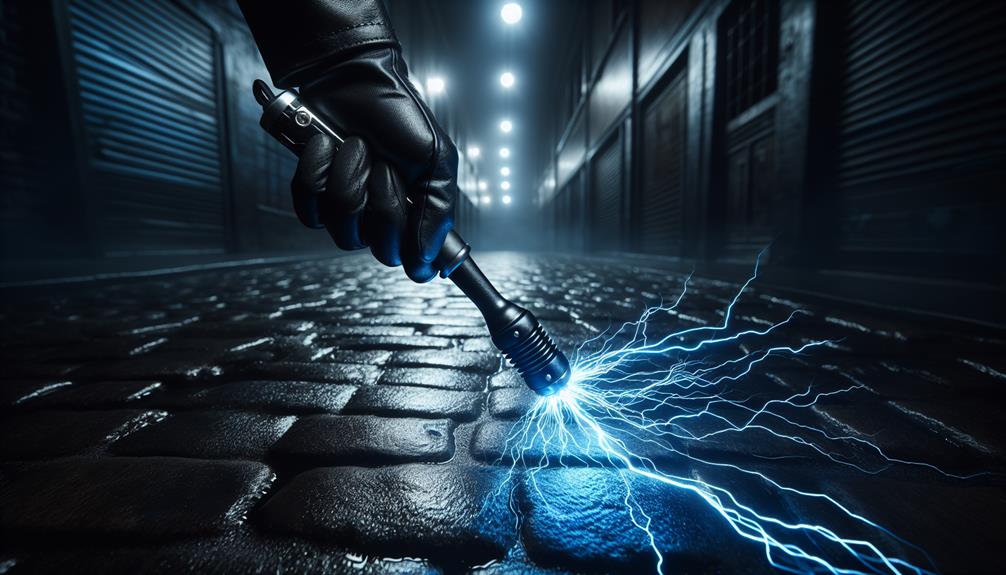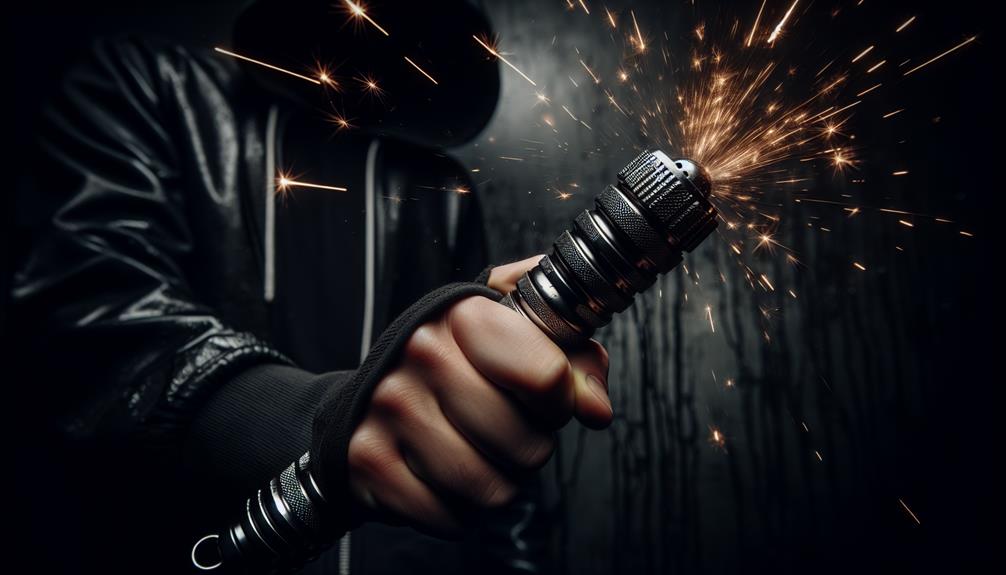The Shocking Truth: Can You Really Withstand a Stun Baton Attack?

You’d be in for a rough ride facing a stun baton attack. With a jolting 12 million volts, it’s not just an electric shock; it’s a full-body rollercoaster of pain and muscle spasms. Imagine trying to dance while being zapped—it disrupts your neuromuscular system, making it nearly impossible to move. The pain can feel like a lightning bolt, and even the toughest folks might struggle to maintain their composure. Recovery depends on your pain threshold and physical shape, but temporarily, you’re immobilized. And, if you’re curious about what happens next, you’re in for even more surprising details.
Understanding Stun Batons

Stun batons, combining a high-voltage stun gun with a police-grade baton, offer a powerful tool for non-lethal self-defense. Imagine wielding a device that not only packs a punch but also delivers 12 million volts of electricity, enough to incapacitate an assailant from a safe distance. It’s like having a superhero gadget in your hands!
These stun batons often come with extra features to enhance their effectiveness. Stun gun strips and rough edges can make it even more difficult for an attacker to disarm you, while a rubber grip guarantees you won’t lose your hold during a confrontation.
And let’s not forget the integrated flashlight, a multi-purpose tool that can help you identify threats, blind potential attackers, and illuminate your way in dark alleys.
Whether you’re a security guard, a law enforcement officer, or even someone dealing with aggressive animals, these tools are designed to give you the upper hand. They’re also great for elderly or disabled adults seeking an additional layer of personal protection.
With all these features packed into one device, stun batons are the Swiss Army knives of self-defense tools—minus the toothpick!
Mechanism of Action
When you activate a stun baton, it delivers a high-voltage electric shock through direct contact, disrupting the body’s neuromuscular system. This disruption causes involuntary muscle contractions and temporary paralysis, making it a highly effective self-defense tool.
Imagine facing an assailant and, with just a press of a button, the stun baton releases a powerful jolt—thanks to voltage levels that can reach 12 million volts or more. It’s like flipping a switch that momentarily disconnects the brain’s control over the muscles.
Stun batons are unique because they combine the physical deterrent of a baton with the electrical incapacitation of a stun gun. This dual function allows you to maintain a safe distance from the threat while delivering a potent shock that can subdue even the most determined attacker.
The baton part can fend off close encounters, while the electric shock makes sure they won’t be getting up anytime soon.
Physical Effects on the Body

When you’re hit by a stun baton, brace yourself for some serious pain and muscle spasms that can leave you feeling like you’ve just tried to dance the cha-cha with an electric eel.
These shocks cause intense pain and can make your muscles contract uncontrollably, leading to temporary immobility.
It’s like your body gets a harsh reminder of why sticking a fork in a toaster is a bad idea, and the incapacitation is immediate, making it a highly effective self-defense tool.
Pain and Muscle Spasms
Experiencing a stun baton attack can inflict intense pain and immediate muscle spasms that severely impair your ability to move. Unlike Tasers, which often target the central nervous system, stun batons deliver a high-voltage shock directly to the muscles, causing rapid and uncontrollable contractions.
Imagine trying to run while every muscle in your leg seizes up like it’s been hit by a bolt of lightning—it’s not happening.
The electric shock from a stun baton can overload your nervous system, sending your muscles into overdrive and making it almost impossible to resist or fight back. You might think you can tough it out, but the reality is, the pain is immediate and intense, leaving you gasping and disoriented.
These muscle spasms aren’t just inconvenient; they can be downright incapacitating. Picture trying to dial a phone with hands that are twitching uncontrollably.
The severity of these effects can vary, depending on your pain tolerance and overall health, but the result is usually the same: a temporary but powerful disruption to your body’s normal function.
Temporary Immobility Effects
A stun baton‘s high-voltage shock can quickly disrupt your neuromuscular system, leading to immediate and temporary immobility. When hit by a stun, your muscles involuntarily contract, causing you to lose balance and potentially fall to the ground. This sudden loss of control can feel like your body has turned into a rebellious puppet, refusing to obey your commands.
The electrical shock not only induces pain but also causes these intense muscle contractions, making it nearly impossible to move. Imagine trying to run or even stand up straight when your muscles are playing a chaotic game of freeze tag—it’s just not going to happen. This temporary paralysis is designed to incapacitate you, giving you no choice but to pause and, hopefully, rethink any aggressive intentions.
Stun batons are engineered to deliver these high-voltage shocks specifically to immobilize and deter attackers. The physical effects can be remarkably effective, often rendering you temporarily incapable of any physical action. This brief window of immobility can provide significant time for escape or self-defense.
Pain Tolerance Levels
Pain tolerance levels can greatly influence how well you withstand a stun baton attack. Your ability to handle pain varies widely, swayed by factors like adrenaline, physical fitness, and mental preparedness.
Imagine being in the middle of a high-stakes situation—your heart’s racing, adrenaline’s pumping. That adrenaline rush can temporarily boost your pain tolerance levels, making you a bit more resilient to the jolt of a stun baton.
However, don’t get too confident; the intensity of pain from a stun baton can range from a sharp pinch to feeling like you’ve been hit by lightning, depending on the voltage and duration. If you’ve got a high pain threshold, you might endure the shock a bit longer before it knocks you off your feet.
But remember, even the toughest individuals can be overwhelmed by the stun baton’s combination of pain, muscle contractions, and neuromuscular disruption.
Training in self-defense and mental conditioning can help you better cope. Picture Rocky training montages—okay, maybe a bit less intense—but prepping your mind and body can make a significant difference.
Psychological Impact

How does a stun baton attack affect your mind and emotions?
A stun baton attack doesn’t just jolt your body; it rattles your psyche too. The psychological impact can be profound. Imagine the sound of that electric crackle—it’s enough to send your stress levels skyrocketing. Your body goes into fight-or-flight mode faster than you can say ‘stun baton,’ flooding you with fear and anxiety.
The sight of the baton alone can make you feel powerless and vulnerable, as if control has been snatched away. This sense of helplessness can linger, causing long-lasting emotional distress. Some people may even develop post-traumatic stress symptoms, reliving the terror long after the event. It’s not just the direct victims who suffer; witnessing or even hearing about such attacks can create a ripple effect of insecurity within communities.
Feeling anxious yet? That’s the harsh reality. You’re not just dealing with the physical pain; you’re battling an emotional storm too. The psychological impact can be as debilitating as the shock itself, leaving scars that aren’t visible but are just as real.
Duration of Incapacitation
The duration of incapacitation from a stun baton attack can range anywhere from 5 to 60 minutes, heavily influenced by the duration and intensity of the shock delivered. Imagine getting zapped by a high-voltage stun baton; it’s not just a brief jolt, but something that can leave you immobilized for quite a while. The length of incapacitation hinges on factors like the voltage and amperage of the device. Higher voltage stun batons, delivering increased microcoulombs, tend to result in longer periods of incapacitation.
Now, everyone’s response to a stun baton varies. Your pain tolerance, physical condition, and mental resilience all play significant roles. Someone in peak physical shape might recover more swiftly compared to someone with a lower threshold for pain. Think of it like this: if you’re accustomed to handling pain, you might shake off the effects quicker, but if not, you could be down for the count.
These devices are designed to provide temporary paralysis, giving you or someone else a chance to escape or subdue an assailant. So, if you ever find yourself on the receiving end, know that the incapacitation is temporary, but its duration can certainly feel like an eternity!
Long-Term Consequences
When you’re hit by a stun baton, the immediate shock is just the beginning—nerve damage risks and chronic pain can linger, turning everyday activities into a struggle.
Imagine trying to enjoy a walk in the park but being constantly on edge, fearing another attack, while dealing with the searing pain that refuses to fade.
The psychological aftereffects, like anxiety and PTSD, can make even grocery shopping feel like traversing a minefield, leaving you wondering if you’ll ever feel safe again.
Nerve Damage Risks
Pivotal exposure to a stun baton can occasionally lead to nerve damage, resulting in chronic pain, numbness, or tingling. Imagine the shock to your system; it’s not just a fleeting sensation but potentially a long-term issue. Nerve damage, while rare, can seriously disrupt your life if you’re one of the unlucky ones to experience it.
When a stun baton makes contact, the electric jolt can sometimes damage the nerves, especially if the exposure is extended. This damage might manifest as:
- Chronic pain that lingers long after the initial jolt.
- Numbness in areas where the stun baton was applied, making it difficult to perform everyday tasks.
- Tingling sensations that can be both annoying and alarming, reminding you of the incident every time they occur.
The severity of nerve damage hinges on the intensity and duration of the shock. If after a stun baton encounter you notice persistent pain or unusual sensations, seek medical attention immediately.
It’s essential to use stun batons responsibly, recognizing the real risks involved. Misuse can lead to unintended, long-term consequences, turning a self-defense tool into a source of ongoing agony. Don’t underestimate the impact; your nerves (and future self) will thank you.
Chronic Pain Potential
Chronic pain from stun baton attacks can drastically alter your daily life and overall well-being. Imagine waking up every day with persistent muscle soreness or neuropathy, the type of chronic pain that makes even simple tasks seem like challenging feats. The repeated shocks can lead to long-term nerve damage, leaving you with sensory issues in the affected areas. It’s like your body is constantly reminding you of that one shock (or maybe multiple) that changed everything.
You might find yourself needing ongoing medical treatment, from pain management therapies to possibly even surgeries. Chronic pain isn’t just a physical burden; it can seep into every facet of your life. Research shows that those frequently subjected to stun baton attacks often develop long-lasting pain syndromes and physical limitations, turning daily activities into demanding challenges.
Here’s a quick snapshot of the long-term consequences:
| Impact | Details |
|---|---|
| Neuropathy | Long-term nerve damage with sensory loss |
| Muscle Soreness | Persistent discomfort and tightness |
| Daily Activity Impact | Difficulty in performing routine tasks |
| Medical Treatment | Ongoing therapies and possible surgeries |
Psychological Aftereffects
The psychological aftereffects of a stun baton attack can leave you grappling with trauma, anxiety, and even post-traumatic stress disorder. The psychological impact of such an experience can be profound, altering your sense of safety and trust in the world around you. Victims often find themselves haunted by nightmares and flashbacks, replaying the traumatic event over and over.
Imagine waking up in a cold sweat, your heart racing, as you relive the attack in your dreams. You might feel a constant sense of vulnerability, fearing another attack could happen at any moment. This heightened state of anxiety can make it difficult to trust others, impacting your relationships and daily interactions.
- Nightmares that disrupt your sleep and leave you exhausted
- Flashbacks that transport you back to the moment of the attack
- A pervasive fear that affects your ability to engage with the world
Coping with these long-term consequences often requires significant effort. Therapy and support groups can provide a safe space to process your emotions, while self-care practices like mindfulness and exercise can help manage stress. The road to recovery may be long, but with the right support, you can regain control over your life.
Practicality in Self-Defense
When considering self-defense tools, stun batons stand out for their practicality and effectiveness. These devices combine the physical deterrence of a baton with the electrical shock of a stun gun, making them a versatile choice.
Picture this: you’re walking home late at night, and someone suspicious approaches. With a stun baton, you’ve got the reach to keep them at bay and the high-voltage shock to incapacitate them if necessary.
The intimidation factor alone can deter potential attackers. Just the sight and sound of the electric crackle can make someone think twice. Plus, many stun batons come with built-in flashlights, adding an extra layer of utility and safety in dark environments.
You don’t have to be a martial arts expert, either. The baton’s long reach means you can defend yourself without getting too close to the threat, reducing the risk of a physical altercation.
For professionals like security personnel or individuals simply wanting peace of mind, stun batons offer a powerful, non-lethal option. They’re practical, easy to use, and provide a solid sense of security, making them a smart choice for anyone serious about self-defense.
Legal and Ethical Considerations

While stun batons offer practical self-defense solutions, it’s important to understand the legal and ethical considerations surrounding their use. Legal considerations for carrying and using stun batons vary greatly by state, and some states outright prohibit their possession. Before you even think about purchasing one, you need to be aware of your local laws to avoid any legal trouble.
Imagine the sheer frustration of facing legal consequences simply because you were trying to protect yourself.
- Legal restrictions: Some states have strict laws against stun batons.
- Proportionate force: Using more force than necessary can lead to severe legal repercussions.
- Potential harm: Ethical dilemmas arise when considering the harm you might inflict on another person.
Ethically speaking, the use of a stun baton must be proportionate to the threat you face. You wouldn’t want to be in a situation where your self-defense measure is viewed as excessive force. Remember, the goal is to reduce harm, not escalate violence.
The ethical implications involve weighing your safety against potential harm to the attacker. Make sure you’re informed and prepared, so you can make the right decision when it counts.
Frequently Asked Questions
How Effective Is the Stun Baton?
You’re wondering how effective a stun baton is. With police training, these devices deliver 12 million volts, combining a baton’s force with a stun gun’s shock. They’re designed for maximum effectiveness, enhancing personal safety and incapacitating threats instantly.
Will a Stun Gun Incapacitate Someone?
Yes, a stun gun can incapacitate someone by disrupting their neuromuscular system, causing temporary paralysis. However, you should consider the legal implications of using one, as they vary by location and situation.
Is It Possible to Withstand Taser?
Withstanding a Taser is incredibly tough. Your pain tolerance, physical condition, and clothing thickness all play roles. Even with high pain tolerance, neuromuscular incapacitation from the electrical current can lead to temporary paralysis and intense muscle contractions.
Which Is Stronger, a Taser or a Stun Gun?
When comparing voltage, Tasers and stun guns differ. Tasers have varying voltage levels, while stun guns typically exceed 50,000 volts. However, effectiveness isn’t just about voltage; it also depends on microcoulombs delivered for best impact.


One Response